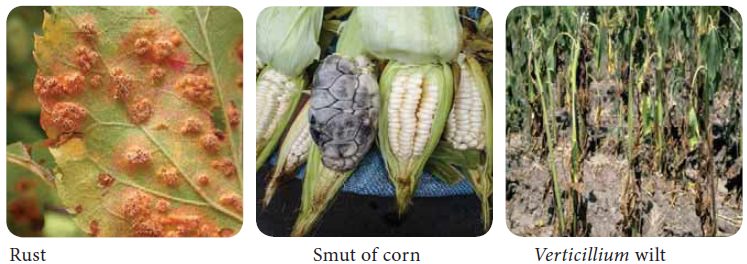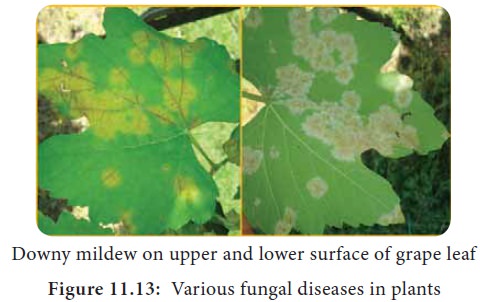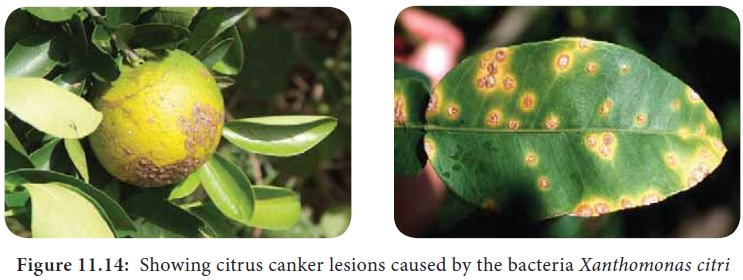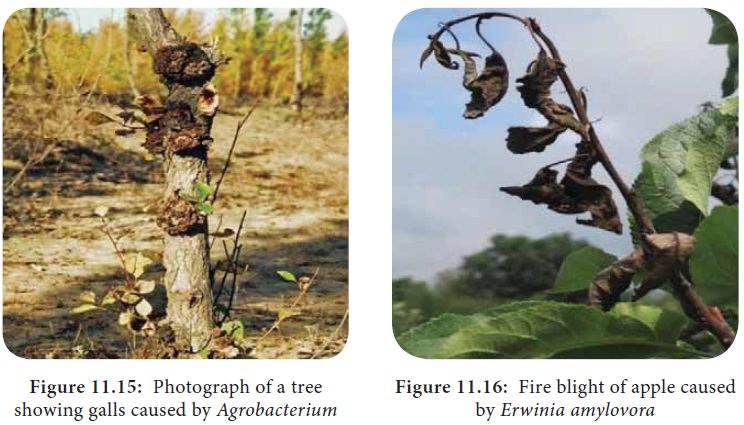Fungal, Bacterial, Viral Diseases - Plant Diseases | 11th Microbiology : Chapter 11 : Agricultural Microbiology
Chapter: 11th Microbiology : Chapter 11 : Agricultural Microbiology
Plant Diseases
Plant Diseases
The study of the nature, causative agent, development and
control of plant diseases is called plant pathology. The study of plant
diseases is important because man is directly and indirectly dependent upon
plants for his survival and plants are the source of food, fibre and drugs.
Impact of plant diseases on human welfare
History proves us that plant diseases had caused severe famine
in the early centuries as a result of which millions of people died and was
forced to migrate out of their country. Plantations were wiped out and agro
industries failed and shortage of food resulted due to microbial attack on
plants.
Example: In 1840, late blight disease of potato has caused
severe famine in Ireland
In 1942, Bengal famine in India was due to Helminthosporium
disease of rice caused by Helminthosporium
oryzae.
The various diseases caused on plants by micro organisms can be
broadly grouped into the following kinds.
Fungal Diseases
Most of the diseases of plants are caused by fungi. They exhaust
all the nutrients from the plants and exhibit a wide variety of symptoms on
leaves, stem and inflorescence. The common symptoms are given below.
Rusts
It is a plant disease caused by the rust fungus of the class
Uredinomycetes. Example: Puccinia sp.
The leaves have characteristic spots or pustules which are rust colored, yellow
or brown that bear spores of the infecting fungi.
Smuts
This plant disease is caused by a fungus of the order
Ustilaginales. The plant parts contain black, powdery masses of spores that
appear as sooty smudges.
Wilts
It is due to the deficiency of water in the foliage, which
results in the death of shoots and large branches. Several fungi like Fusarium, Verticillium cause wilt by
plugging up the xylem and phloem vessels of the plant.
Downy mildew
This disease is characterised by the formation of downy growth
(covered with soft, fine hairs) on the undersurface of the leaves with a
corresponding yellowish patch on the top of the leaves. The causative fungus
belongs to the order Perenosporales
The other fungal diseases of plants include Powdery mildews,
Rots, Damping off, Leaf spots (Figure 11.13) and Blights.


Bacterial Diseases
The common bacterial diseases of plants are bacterial leaf spot,
crown gall and fire blight.
Bacterial leaf spot
Plants that are infected with bacterial leaf spot will develop
dark-colored, water-soaked spots that are accompanied by

Continuous rain and moisture will cause the coalescence of the spots. Severely infected leaves will defoliate prematurely. Bacterial leaf spot is a common nuisance of citrus (Figure 11.14) and stone fruit trees and vegetables, as well as other indoor and outdoor foliage plants.
Crown gall
Crown gall is a root and stem disease that is most commonly found on woody plants. Infected plants will develop smooth, light-colored galls on its roots and stems. These formations inhibit the plant’s ability to transport nutrients and water throughout the plant.
This results in loss of vigor of plant which is also
accompanied by growth stunt and dieback of branch and twigs (Figure 11.15)
Crown gall disease is a soil-borne bacterial disease caused by Agrobacterium sp.

Fire blight
Fire blight is a destructive bacterial disease that is
especially threatening to rosebushes and pome fruit trees like apple and pear.
Trees and plants that are infected with fire blight will display tan-colored,
bacterial ooze near the points of infection (Figure 11.16) The infected areas
become necrotic, turn black, wilt and become deformed.
Viral Diseases
Viruses are obligate parasites and require a wound to gain entrance to a plant cell. In nature, they depend primarily on biological agents such as nematodes, insects and man for their dissemination. Once duplication starts, the virus is translocated from cell to cell through the plasmodesmata and to distant plant parts by the phloem. Some viral diseases are very host specific, and others are general, over many hosts. Symptoms include stunting, mosaic, ring spots, color breaks, and distortion.

Common plant viruses are tobacco mosaic virus (Figure 11.17) Cauliflower mosaic virus, Impatiens Necrotic Spot Virus (INSV), tomato spotted wilt virus, ajuga viruses, and cucumber mosaic virus
Late blight of potato
Causative organism: Phytophthora
infestans
Late blight is the disease that triggered the Irish potato
famine of the 1840s which resulted in the death and starvation of 1 million
people. It also was the first plant disease for which a microorganism was
proved to be the causal agent, leading to the birth of plant pathology as a
science (Figure 11.18)

Phytophthora infestans
is a member of the oomycetes, a group of organisms
sometimes referred to as the “water molds”. During asexual reproduction, Phytophthora infestans
produces sporangia on sporangiophores. In cool, wet
conditions, zoospores will form and emerge from the sporangia after about two
hours. In warmer conditions, sporangia may function as a single spore and
germinate directly. Zoospores are biflagellate (have

After swimming on the surface of
the host plant surface, zoospores encyst and infect the plant. During sexual
reproduction, mating between opposite mating types happen. A nucleus from the
antheridium (Male) enters the oogonium (female). Following karyogamy (the
fusion of two nuclei), a thick-walled, diploid oospore is formed. From oospore,
sporangium develops and the life cycle (Figure 11.19) continues.
Lesions on stems and leaves
Late blight of potato is identified by black/ brown lesions on leaves and stems that may be small at first and appear water soaked or have chlorotic borders, but soon expand rapidly and become necrotic. In humid conditions, Phytophthora infestans produces sporangia and sporangiophores on the surface of infected tissue.
This
sporulation results in a visible white growth at the leading edge of lesions on
abaxial (lower) surfaces of leaves. As many lesions accumulate, the entire
plant can be destroyed in only a few days after the first lesions are observed
Lesions on tubers
Tuber infection symptoms are a darker brown sometimes purplish
area on the tuber surface. The internal rot is a reddish brown granular rot
which can remain close to the surface or progress to the centre of the tuber.
Rot development is irregular and sometimes threadlike through the tuber flesh.
Late blight causes skin damage which allows opportunistic bacteria to invade
and cause soft rotting.
Epidemiology
Temperature and moisture are the most important environmental
factors affecting late blight development. Sporangia are formed on the lower
leaf surfaces and infected stems when relative humidity is < 90%.
Sporulation can occur from 3-26°C, but the optimum range is 18-22°C. Sporangia
germinate directly via a germ tube at 21-26°C.
Control
Fungicide applications are an important means of late blight
management, particularly in humid areas. They must be applied before plants are
exposed to spores. Copper hydroxide (2g/lit), chlorothalonil (2g/lit) and
mancozeb (2.5g/lit) fungicides are the standard protectants used for control.
they are usually applied every seven to ten days for best protection.
Related Topics